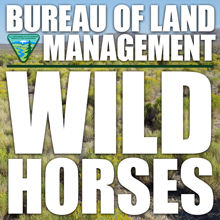
On Tuesday, the Bureau of Land Management released its annual wild horse and burro population estimates, which show a marked reduction in wild horse and burro overpopulation on public lands.
This is the third year since 2020 that the overpopulation of wild horses and burros has declined.
The BLM estimates there were approximately 73,520 federally-protected wild horses and burros on BLM-managed public lands as of March 1st, 2024 – 9,363 fewer animals than what was estimated in 2023.
Due to the realities of aerial and statistical analyses, the population estimate accounts for a range of uncertainty between 63,432 animals to 85,249 animals.
“Protecting and managing wild horses and burros on public lands is a responsibility that the BLM takes extremely seriously,” said BLM Director Tracy Stone-Manning.
“By addressing overpopulation, we are not only ensuring the long-term well-being of wild horses and burros but also safeguarding the delicate balance of our ecosystems for the benefit of all wildlife and the health of our public lands.”
Though the exact causes of the population reduction cannot be definitively determined, the BLM has taken steps in recent years to address overpopulation.
For example, since the March 2023 estimates were released, the BLM removed 11,784 animals from overpopulated herds and offered them for adoption to qualified homes. Since then, BLM has placed 7,887 animals into private care through adoptions, sales and transfers.
Between 2020 and 2023, the BLM removed about 50,000 wild horses and burros. This compares to about 27,000 animals that were removed in the prior four years, 2016-2019. The BLM has also worked to increase the use of fertility control vaccines that could be contributing to slower growth for some herds.
From 2020 to 2023, about 4,237 treatments were conducted, compared to 2,606 treatments conducted 2016-2019.
In addition, most of the Western U.S. experienced a severe 2022-2023 winter with deep snow, which impacted wildlife populations and may have increased mortality in some wild horse herds, or caused animals to disperse to other areas unknown to surveyors.
Though this latest estimate represents the largest one-year reduction in overpopulation since 1985, the estimated population remains nearly three times what scientists estimate public lands can sustainably support.
The BLM plans to continue efforts to bring wild horse and burro populations back to a healthy level. The agency recently released its plan to gather and remove approximately 20,000 wild horses and burros and treat 1,400 horses with fertility control in Fiscal Year 2024, with the added goal of placing 10,000 animals into private care through adoptions and sales. Based on population projections, approximately 20,000 animals should be removed annually, and the use of fertility control should be maximized where it can be effective, to continue the downward trend.
The BLM is mandated by the Wild Free-Roaming Horses and Burros Act to manage and protect wild horses and burros as part of a thriving natural ecological balance on public lands.
Because wild horse and burro populations on public lands increase rapidly, the BLM must gather and remove excess animals to keep herds from overpopulating their habitat.
Animals removed from overpopulated herds are checked by a veterinarian and prepared for adoption to qualified homes. The BLM also uses various fertility control vaccines that can prevent pregnancy in wild mares for 1-4 years.
For more than a decade prior to 2020, wild horse and burro populations saw rapid growth, rising from approximately 28,500 animals in 2007 to a peak of more than 95,000 animals in 2020.
When chronically overpopulated, wild horse and burro herds degrade important ecosystems, which can eventually lead to starvation and dehydration for the wild horses and burros, and impact other wildlife.
The BLM continues working to place excess animals into private care through its Adoption and Sales Programs as well as successful partnerships with organizations across the nation.
There are many opportunities to get involved in these efforts as a volunteer, partner, or donor. Since 1971, nearly 300,000 horses have been placed into private care, becoming excellent pleasure, show and work horses for families nationwide and even overseas. More information on how you can adopt a wild horse or burro can be found here.
The BLM compiles annual wild horse and burro population estimates based on data collected by field specialists using scientifically validated aerial survey techniques developed by U.S. Geological Survey scientists. Statistical analysis of the data leads to an estimated total number of animals, including those that may be missed during the survey.
The BLM normally surveys about one third of all herds using this methodology each fiscal year. For herds not surveyed in a given year, the BLM typically assumes 20 percent growth for horses and 15 percent growth for burros.





